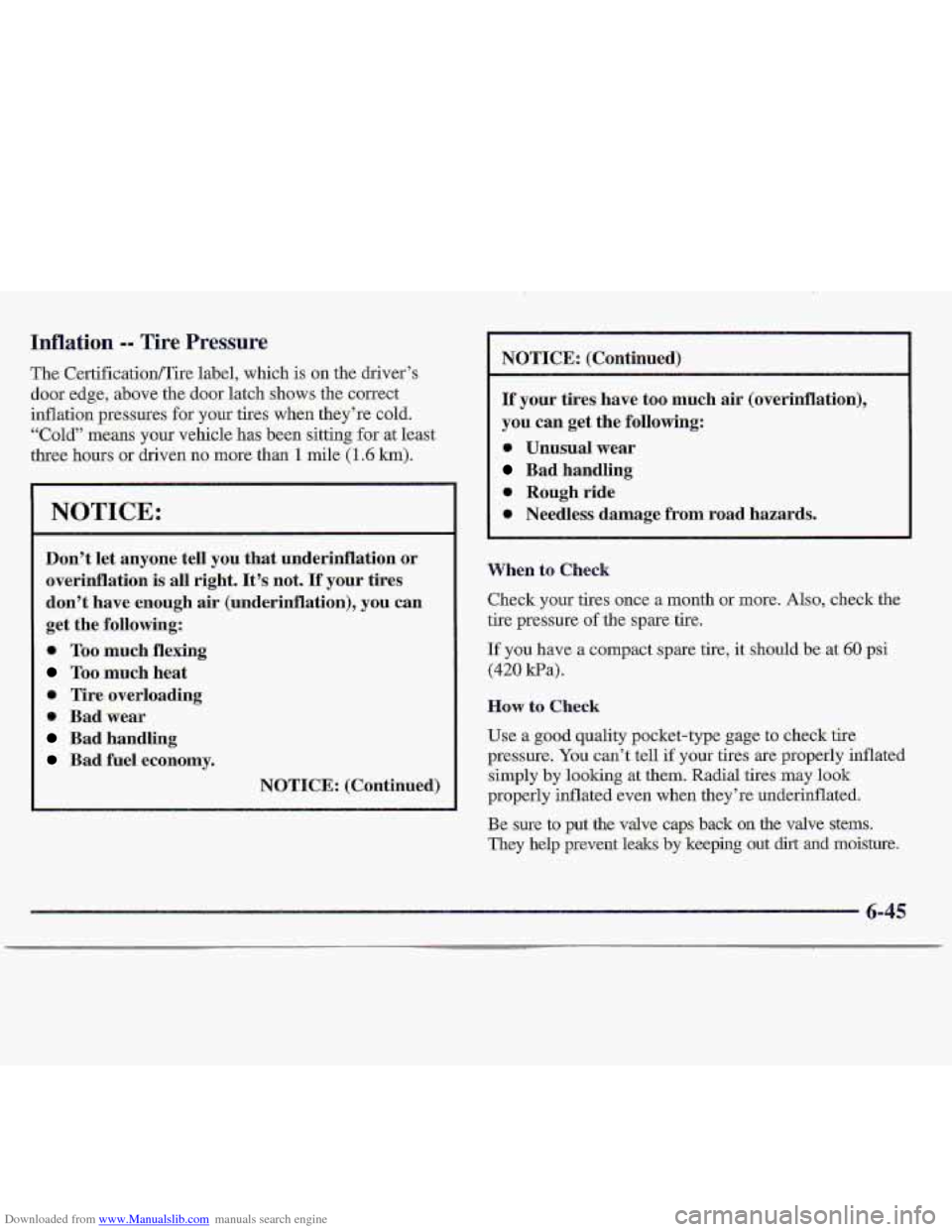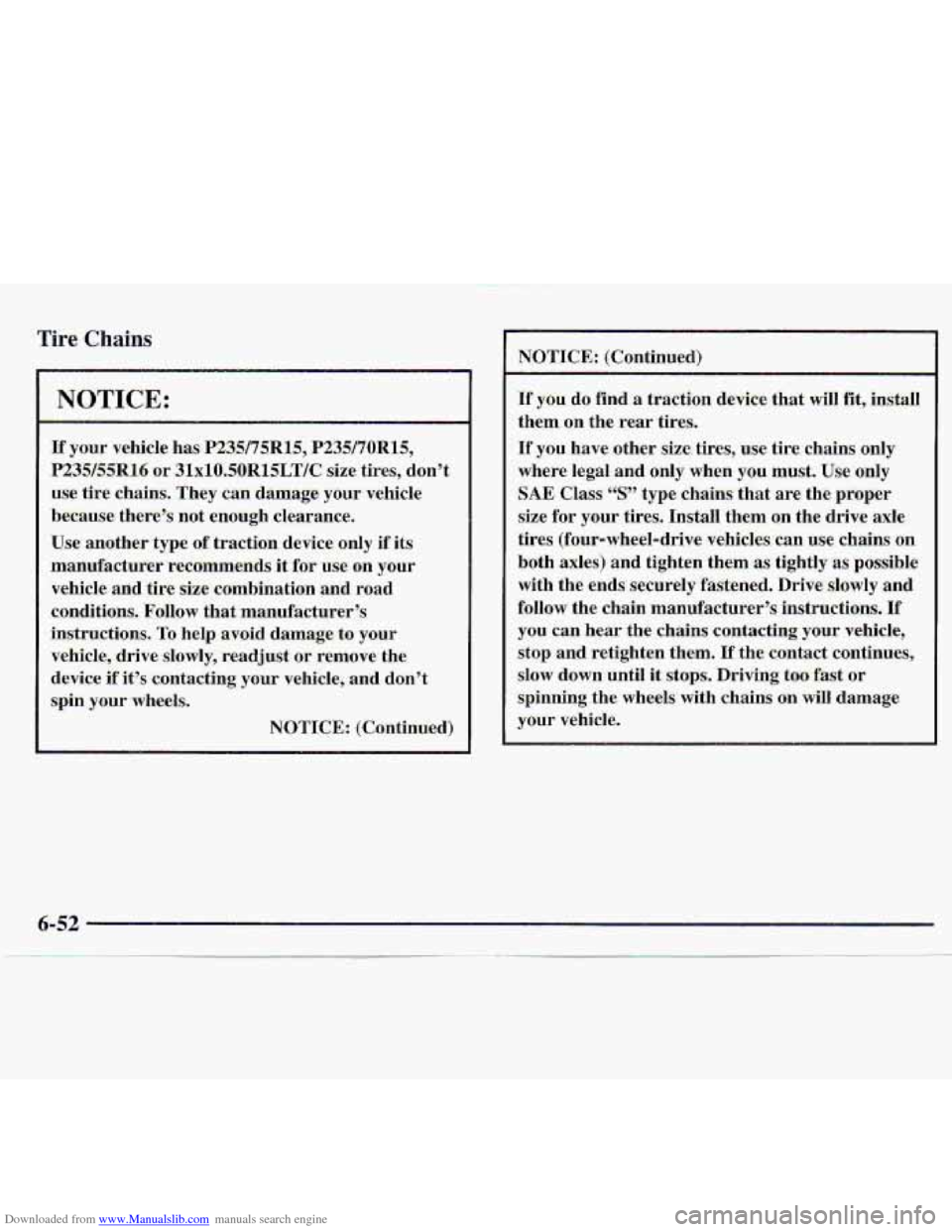Page 282 of 402

Downloaded from www.Manualslib.com manuals search engine Inflation -- Tire Pressure
The CertificationlTire label, which is on the driver’s
door edge, .above .the door latch shows the correct
inflation pressures for your
tires when they’re cold.
“Cold” means your vehicle has been sitting
for at least
three hours
or driven no more than 1 mile (1.6 km).
NOTICE:
Don’t let anyone tell you that underinflation or
overinflation is all right. It’s not. If your tires
don’t
have enough air (underinflation), you can
get
the following:
Too much flexing
Toa much heat
@ Tire overloading
0 Bad wear
Bad handling
Bad fuel economy.
NOTICE: (Continued)
NOTICE: (Continued)
If your tires have too much air (overinflation),
you can get the following:
9 Unusual wear
Bad handhg
0 Rough ride
1) Needless damage from road hazards.
When to Check
Check your tires once a month or more. Also, check the
tire pressure
of the spare tire.
If you have a compact
spare tire, it should be at 60 psi
(420 kPa).
How to Check
Use a good quality pocket-type gage to check tire
pressure.
You can’t tell if your tires are properly inflated
simply by looking at them. Radial tires may
look
properly inflated even when they’re underinflated,
Be sure to put the valve caps back on the valve stems.
They help prevent leaks by keeping out dirt and moisture.
6-45
Page 285 of 402
Downloaded from www.Manualslib.com manuals search engine Buying. New Tires
'If you 'eve.r replace your tires with those- not :having .a
TPC Spec number, make Sure they are the same, size,
load range, speed rating and construction type (bas,
.bias-belted..or radial) as you^ original tires..
Mixing tires could 'cause you to lose control while
driving. If
you mix tires of different: sizes or type-§
(.radial and bias-belted tires), the vehicle may not
handle properly, land you could have .a crash.
Using,tires of different sizes may also cause
.damage to your vehicle. Be sure to use the:.same
size and type tires on all wheels.
It's
all right to drive with your compact spare
(if .you have one), It was developed for use on
your vehkle.
6-48
Page 289 of 402

Downloaded from www.Manualslib.com manuals search engine Tire, Chains
use tire chains. They can damage your vehicle
because there’s not enough clearance.
Use another type
of traction device only if its
manufacturer recommends it
for use on your
vehicle and tire size combination and road
conditions. Follow that -manufacturer’s
instructions.
To help avoid damage to your
vehicle, drive slowly, readjust or remove the
device if
it’s contacting your vehicle, and don’t
spin your -wheels..
NOTICE: (Continued)
’ NOTICE: (Continued)
If you do find a traction device that will fit, install
them on the rear4irgs.
If you have other size tires, use tire chains only
where legal and only when you
must. Use. only
SAE Class “S” type chains that are the proper
size
for your tires. Install them on the drive axle
tires (four-wheel-drive vehicles. can use chains on
both axles) and tighten them as tightly as possible
with the ends. securely fastened. Drive slowly
and
follow the chain manufacturer’s instructions. If
you can hear the chains contztc,ting your vehicle,
stop and retighten them.
If the contact contimes;
slow down until
it stops. Driving toa fast or
spinning the wheels with chains on will damage
your vehicle.